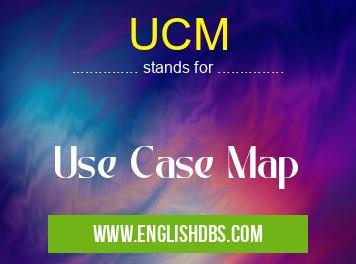What does UCM mean in GENERAL
UCM stands for Use Case Map. It is a graphical representation of a system's use cases, actors and their relationships to one another. A use case map allows the user to easily identify which actors interact with which elements of the system, and how those elements are related to each other. This type of map can be used to define the scope of a project, or as part of a business process analysis. By visualizing the interactions between users and systems, it becomes easier to identify potential design issues or areas of improvement.

UCM meaning in General in Computing
UCM mostly used in an acronym General in Category Computing that means Use Case Map
Shorthand: UCM,
Full Form: Use Case Map
For more information of "Use Case Map", see the section below.
Definition
A Use Case Map (UCM) is an interactive model that diagrams the steps an actor (or user) takes when interacting with an information system or software application. The map illustrates the possible pathways within an application or system's functionality by mapping out its various components, including activities, processes and data stores. It also identifies any external systems and datasets that need to be accessed in order for the actor's usage journey to be completed accurately and efficiently.
Advantages
The main advantage of using a UCM is that it provides a visual representation of how different roles interact with different parts of an information system or software application. It enables project teams to quickly understand how different members interact with the system as well as how they complete specific tasks related to their job role within it. As such, it can help improve collaboration between departments within an organization as well as allow for better communication between stakeholders both internal and external. Additionally, because a UCM is able to provide detailed insight into how a user will navigate throughout an application or website, this information can then be used in order to optimize user experience (UX).
Essential Questions and Answers on Use Case Map in "COMPUTING»GENERALCOMP"
What is a Use Case Map?
A Use Case Map (UCM) is an intuitive map that helps visualize the relations between different elements of a use case. It shows the logical sequence of steps and their relation to each other in a way that is easy to understand. UCMs provide added value for functional analysis, communication among stakeholders, and with customers.
What are the benefits of using a Use Case Map?
Use Case Maps offer several advantages, such as improved clarity and better communication between stakeholders. They also help identify potential risks or areas where additional attention or resources may be required. UCMs can also provide teams with a comprehensive view of the project's progress and help spot any potential issues before they become too big to manage.
How do I create a Use Case Map?
Creating a Use Case Map involves identifying the key processes and activities associated with the use case, mapping out those activities into diagram form, labeling each element or step in the process, and then detailing any associated actors or objects involved in each step. Once complete, you should have an accurate visual representation of how different elements within your system interact together to achieve your desired outcome.
Do I need special software to create a Use Case Map?
No, you don't necessarily need special software to create a UCM. However certain software programs make it easier to design this type of diagram especially if you want something more intricate than just paper & pencil sketches or open source tools like Inkscape or Dia for basic diagrams.
What does an ideal Use Case Map look like?
An ideal UCM should have clearly labelled elements that detail what happens in each step and which actors are involved at each stage. The map should also visually demonstrate dependencies between different steps and be organized logically so as not to confuse decision makers when attempting to decipher its meaning.
Who would benefit from using Use Case Maps?
Professionals who routinely engage in complex problem-solving tasks such as project managers, data engineers, business analysts, architects, product owners etc., can all benefit from having direct access to visualized maps of their project elements— including workflow components- providing an overall better understanding of systems dynamics.
Is there any research on how effective use case mapping can be?
Yes - there is ample evidence that suggests that creating visual diagrams when tackling complex problems can drastically improve comprehension levels amongst decision makers as well as clear up some areas of misunderstanding whilst streamlining communication amongst stakeholders involved in each process — all resulting in enhanced team productivity..
Final Words:
In conclusion, Use Case Maps (UCMs) are very useful tools for creating diagrams that illustrate how various actors interact with information systems or software applications as well as identifying any potential design issues or areas needing improvement. By providing detailed insight into how users will navigate through an application or website, UCMs enable project teams to better collaborate and communicate between stakeholders both internal and external while also allowing them necessary knowledge in order optimize user experience (UX).
UCM also stands for: |
|
| All stands for UCM |
